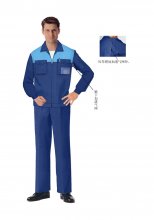Fashion design is a series of work procedures, and each link is connected with each other. The nature of design work, way of thinking, division of labor and collaboration are diverse. Therefore, as the main person responsible for the series of professional clothing design tasks, the designer basically has to run through the entire design process. , and assisted by other designers and personnel. The design process is detailed as follows.

(1) On-site inspection
This is a top-down in-depth inspection, which often requires designers to visit the work site in person to examine the nature of the work, environment, requirements, limitations, taboos (for clothing), as well as the possible injuries and protection between work and professional clothing. Relationship. There are many industries in professional attire, with widely varying requirements and complicated classifications. The result of on-site inspection is to clarify the nuances, rather than relying on design experience and subjective assumptions. For designers of responsible professional attire, this process cannot be omitted.
(2) Sample sealing and try-on
From design renderings to structural design to process design, the pre-sample effect of professional clothing design is basically completed, and then the finished sample clothes are made according to the renderings and sent to the work site for trial fitting for on-site fitting evaluation and related functional and practical performance evaluation. Determination.
(3)Market research
This is different from general fashion design market research, which is divided into two points: macro and micro. From a macro perspective, it studies the current status and characteristics of similar professional attire at home and abroad. From a micro perspective, it focuses on the professional attire needs of enterprises in a specific industry. The research work is summarized as collecting information, listening to opinions, understanding regulations, clarifying standards, research status, etc., thereby forming more detailed written information as the basis for design. In addition to obtaining information from the competent department of the professional attire demand department, information sources can also be obtained from relevant industries, databases, and existing professional attire file accumulation.
(4) Determine the plan
Based on the work results of the first two steps, the design ideas are comprehensively developed and multiple feasible solutions are designed in the form of a series, including style composition, color design, material selection, structural design, accessories, price drafting, cost accounting, concept description, etc. The design plan is in the form of a design draft, changing a series of sub-body designs from a mother body design of one color and one material. The final plan is the result of comprehensive consideration of multiple factors. At the same time, material samples can be selected to predict the ready-made garments. The final effect.
This process is a process of design thinking and image. In order to achieve a balance between the opinions of all parties, it is often expressed in the form of clothing design renderings instead of using direct model three-dimensional design and cutting methods. Therefore, the design plan is expressed in the form of accurate and vivid clothing paintings, which relies on the designer’s strong painting expression ability and aesthetic ability.
Tag: clothing design







